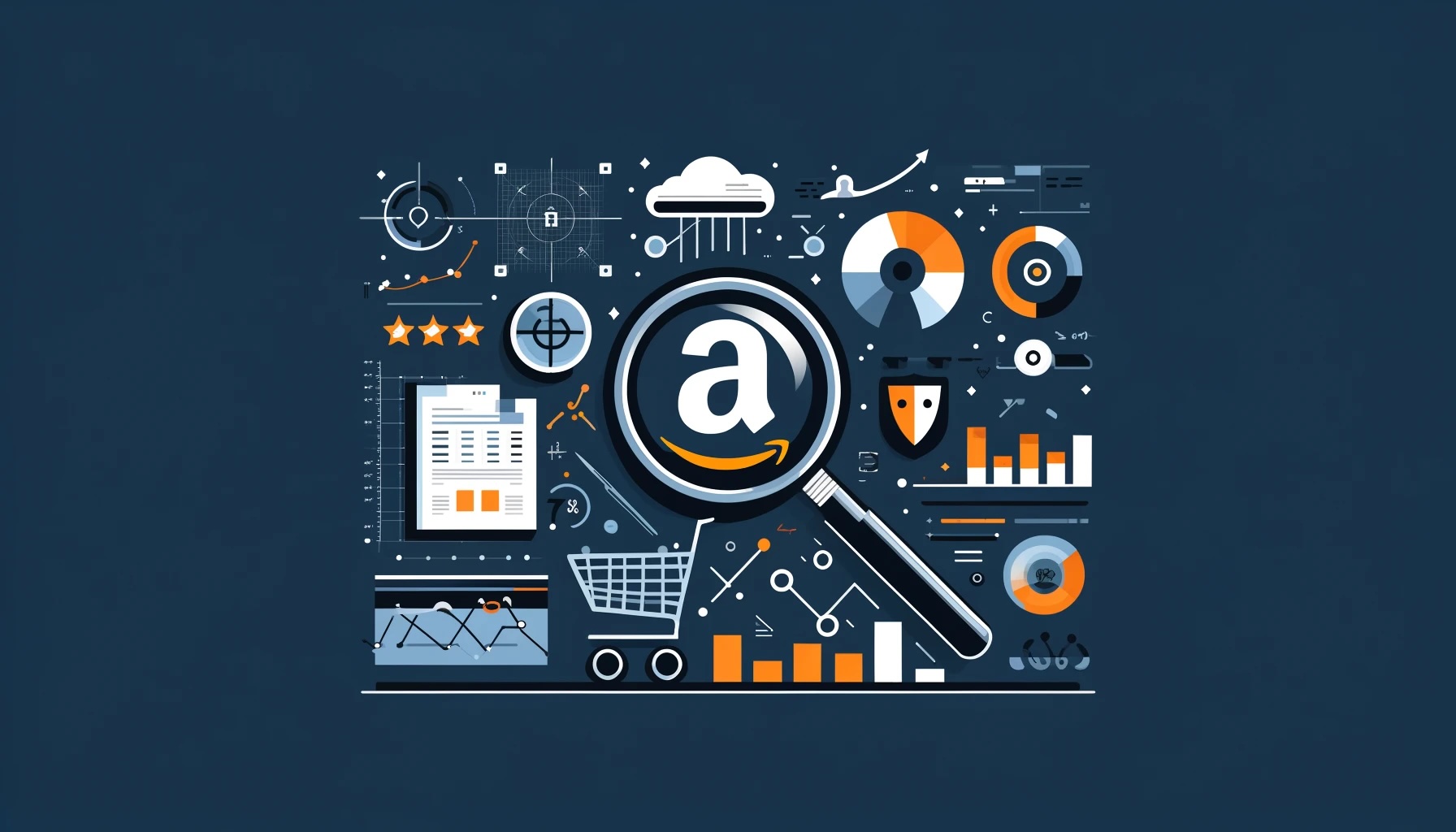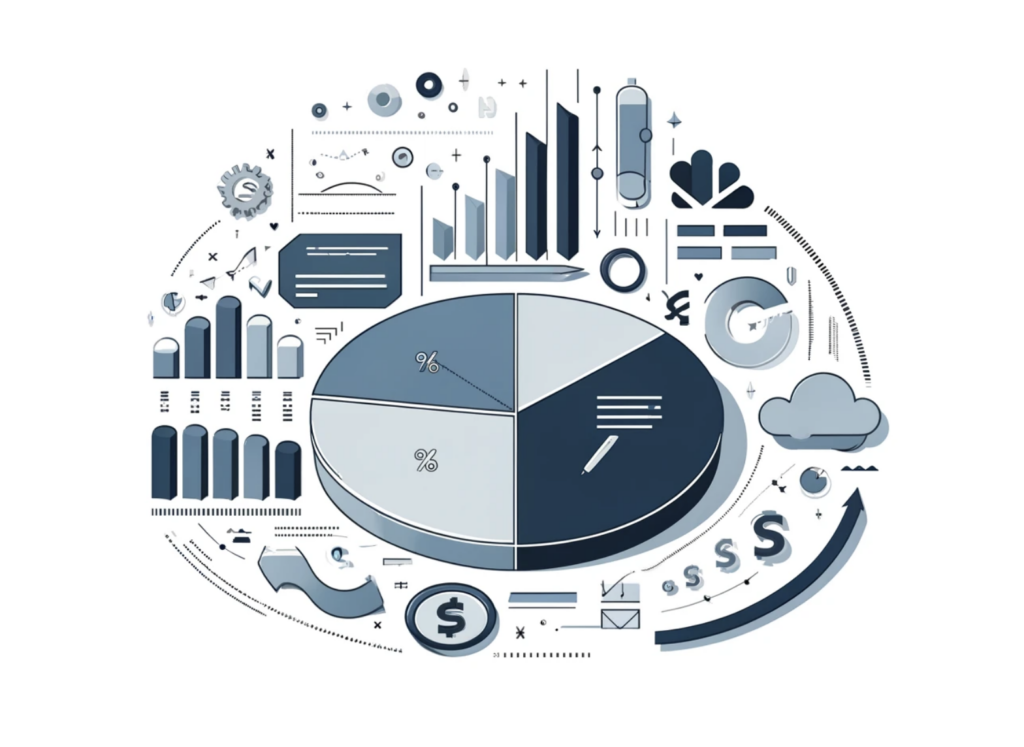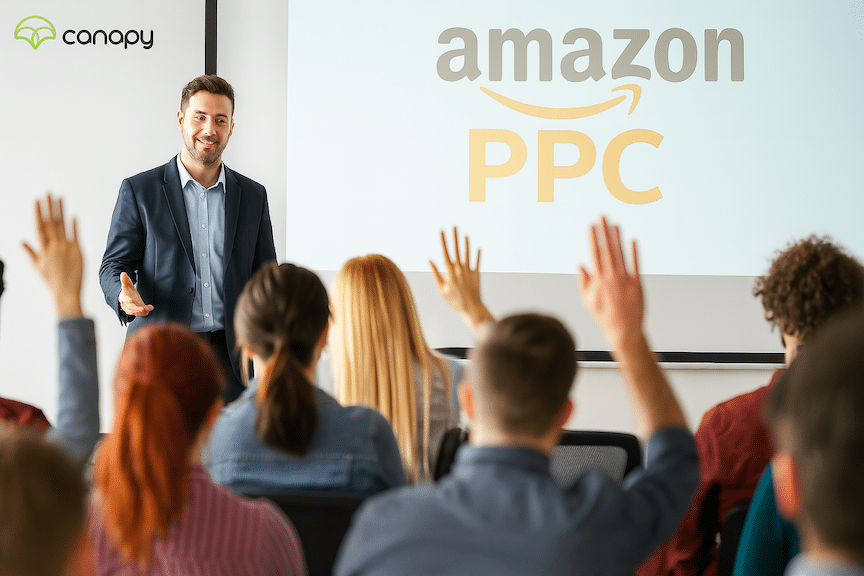The Ultimate Guide to Amazon ACoS and TACoS
Your roadmap to profitable Amazon advertising with proven strategies, current benchmarks, and real optimization tactics.

Last Updated: October 2025
Managing your Amazon advertising campaigns effectively makes the difference between profitable growth and burning cash. Two metrics tell you almost everything you need to know about your advertising performance: Advertising Cost of Sales (ACoS) and Total Advertising Cost of Sales (TACoS).
Here’s what you need to know to use these metrics correctly in 2025 and beyond.
Thinking About Hiring an Amazon Management Agency?
Canopy’s Partners Achieve an Average 84% Profit Increase!
Let’s talkWhat’s New in Amazon Advertising for 2025
Amazon rolled out significant advertising innovations in 2025 that change how you should think about campaign performance. The platform introduced AI-powered contextual pause ads that dynamically align your message with what viewers are watching, creating what Amazon calls “scene-aware ads.” These new formats include live pricing, current deals, and Prime eligibility signals right in the ad unit.
In October 2025, Amazon launched agentic AI creative tools that help you generate and test ad variations faster than ever before. If you’re not using these tools to run more creative tests, you’re leaving money on the table.
According to Amazon Ads, Prime Video’s ad-supported tier now reaches over 130 million U.S. customers monthly, and 88% of those viewers also shop on Amazon. This means your upper-funnel video ads can directly support lower-funnel conversions, making TACoS (which we’ll explain below) more important than ever for understanding your total advertising efficiency.
Understanding ACoS (Advertising Cost of Sales)
ACoS tells you how much you’re spending on ads to generate one dollar of attributed sales. It’s the foundation of profitable Amazon advertising.
The formula:
ACoS = (Ad Spend / Ad Sales) × 100
If you spent $1,000 on ads and those ads generated $5,000 in sales, your ACoS is 20%. You spent $0.20 on advertising for every dollar of revenue those ads directly generated.
2025 benchmark ranges:
- Good (established products): 15–20%
- Platform average: 25–30%
- High (needs attention): 40%+
Your target ACoS depends entirely on your profit margins and business stage. A 30% ACoS might be profitable for a product with 50% margins, but it would lose money on a product with 35% margins.

What Actually Affects Your ACoS
Product price: Higher-priced items usually have lower ACoS because each sale generates more revenue. A $15 product needs to convert twice as well as a $30 product to achieve the same ACoS.
Conversion rate: More clicks turning into sales means lower ACoS. According to 2025 data, Amazon PPC conversion rates average 9.96–10.33%, significantly higher than most other advertising channels.
Click-through rate (CTR): Better CTR means your ads are relevant to what people are searching for. More relevant ads get more sales at lower costs.
Competition and CPC: Amazon’s average cost-per-click in 2025 ranges from $0.99 to $1.04, with seasonal lows around $0.82 and highs hitting $1.14 during peak shopping periods, though this varies significantly by category and competition level. Higher competition drives up your costs.
Product lifecycle: New product launches often require higher ACoS (sometimes 40–50%) to build initial momentum and reviews. Established products should operate at lower, more profitable ACoS levels.
Your Break-Even ACoS
Before you set any targets, calculate your break-even ACoS:
Break-even ACoS = (Unit Margin / Selling Price) × 100
Example: Your product sells for $50. After product costs ($20) and Amazon fees ($12), your unit margin is $18.
Break-even ACoS = (18 / 50) × 100 = 36%
Any ACoS below 36% makes you money. Any ACoS above 36% loses money on each sale. Your target should be below break-even, and the specific target depends on your profitability goals.
How to Lower Your ACoS
Optimize your listings first. No amount of ad spend fixes a listing that doesn’t convert. High-quality images, clear benefits, strong A+ Content, and keyword-optimized copy improve your conversion rate, which directly lowers ACoS.
Use negative keywords aggressively. Check your search term report weekly. Add any irrelevant or low-converting terms as negative keywords immediately. This prevents wasted spend on clicks that won’t convert.
Adjust bids based on performance. Increase bids on keywords generating sales below your target ACoS. Decrease bids on keywords above your target. Use Amazon’s bid adjustment features for placement and device-level optimization.
Test different match types strategically. Broad match discovers new keywords. Phrase match gives you control with some discovery. Exact match maximizes efficiency for proven performers. Use all three in coordinated campaigns.
Structure campaigns by profitability. Keep high-margin products in separate campaigns from low-margin products. This lets you set appropriate ACoS targets for each and allocate budget where it matters most.
Leverage Amazon’s AI bid tools. Amazon’s 2025 optimization features use machine learning to adjust bids based on likelihood to convert. Start with dynamic bids (down only) for new campaigns, then test more aggressive strategies as you gather data.
Thinking About Hiring an Amazon Management Agency?
Canopy’s Partners Achieve an Average 84% Profit Increase!
Let’s talkUnderstanding TACoS (Total Advertising Cost of Sales)
While ACoS measures ad efficiency, TACoS measures how advertising fits into your total business. TACoS is a business health metric, not just a campaign efficiency metric.
The formula:
TACoS = (Ad Spend / Total Revenue) × 100
TACoS includes all revenue (both organic sales and ad-attributed sales), giving you a complete picture of advertising’s role in your business.
Example: You spent $2,000 on ads in a month. Your total revenue that month was $20,000 (including $6,000 from ads and $14,000 organic).
TACoS = (2,000 / 20,000) × 100 = 10%
Your advertising spend represents 10% of total revenue.
Why TACoS Matters More Than You Think
TACoS shows the organic lift your advertising creates. When you improve your product’s relevance through advertising, you climb in organic rankings. This means your TACoS can decrease even while maintaining the same ACoS, because organic sales grow.
Good advertising creates a virtuous cycle:
- Ads drive initial sales and velocity
- Velocity improves organic ranking
- Higher organic ranking generates more organic sales
- More organic sales decrease TACoS
- Lower TACoS creates room to invest more in advertising
Sellers who only watch ACoS miss this bigger picture. You could have a 25% ACoS that looks expensive, but if it’s generating enough organic lift to maintain a 10% TACoS, your advertising is extremely effective.
TACoS Tells You About Business Stage
High TACoS (15–25%): Usually indicates new products, aggressive growth phases, or heavy dependence on paid traffic. This isn’t always bad during launch periods, but it’s not sustainable long-term.
Moderate TACoS (10–15%): Typical for growing brands with decent organic presence. You’re driving growth with ads but also building organic momentum.
Low TACoS (5–10%): Strong organic presence with ads supporting rather than driving most sales. This is the goal for mature, established products.
Very low TACoS (<5%): Either your organic presence is dominant, or you’re underinvesting in advertising and potentially leaving growth on the table.
The ACoS vs. TACoS Framework for Better Decisions
Now that you understand both metrics individually, here’s how to use them together.
Use these metrics at different decision levels:
ACoS is for campaign and keyword-level optimization. When you’re in your campaigns adjusting bids, pruning search terms, or testing new keywords, watch ACoS. It tells you if individual tactics are efficient.
TACoS is for catalog and brand-level strategy. When you’re deciding overall ad budgets, evaluating product viability, or setting growth goals, watch TACoS. It tells you if your advertising creates sustainable business growth.
How to Improve Your TACoS Metrics
Build organic ranking through advertising. Use aggressive ACoS targets during launches (40–50%) to build velocity, then gradually lower ACoS as organic sales increase. The temporary high spend drives long-term efficiency.
Invest in Amazon SEO. Optimized titles, backend keywords, A+ Content, and Brand Stores improve organic discoverability. Better organic ranking means lower TACoS without reducing ad spend.
Use video content in listings and ads. According to Amazon’s 2025 data, video significantly improves conversion rates. Video ads in Sponsored Brands and DSP campaigns, combined with video in your listings, create better engagement at both paid and organic levels.
Test creative more frequently. With Amazon’s new AI creative tools launched in October 2025, you can generate and test ad variations faster. Higher CTR and conversion rates from better creative improve both ACoS and TACoS.
Drive external traffic strategically. Amazon’s A10 algorithm prioritizes external traffic. Use social media, influencer partnerships, and the Brand Referral Bonus program to drive qualified external traffic that boosts organic ranking.
Expand your catalog. More products create more organic discovery opportunities and reduce reliance on any single product’s advertising. Catalog diversification naturally improves overall TACoS.

Current Advertising Benchmarks
Understanding where you stand relative to the market helps you set realistic targets. These benchmarks vary by product category, with highly competitive categories like supplements or electronics often seeing higher CPCs and ACoS.
Average metrics across Amazon:
- Cost per click: $0.99–$1.04 (seasonal range: $0.82–$1.14)
- Conversion rate: 9.96–10.33%
- ACoS: ~25–30% platform average
- Good ACoS for established products: 15–20%
By product lifecycle:
- Launch phase (0–3 months): 40–50% ACoS acceptable
- Growth phase (3–12 months): 25–35% ACoS target
- Maturity phase (12+ months): 15–25% ACoS target
These are guidelines, not rules. Your specific targets depend on margins, competition, and business goals.
Advanced Amazon Strategies
Creative Velocity Wins
Amazon’s October 2025 AI creative tools let you generate and test variations at scale. Winning advertisers in 2025 are running continuous A/B tests on:
- Ad images and lifestyle shots
- Headline variations
- Feature callouts
- Price presentation
- Promotional messaging
Test at least one new creative element every two weeks. Small improvements in CTR compound dramatically over months.
Video Ads Are No Longer Optional
With Prime Video reaching over 130 million U.S. customers monthly and Amazon’s expanded video ad formats throughout the marketplace, video is core to modern Amazon advertising funnels.
Use Sponsored Brands video to capture attention in search results. Amazon DSP video on Prime Video will help you reach shoppers earlier in their journey. Use product listing videos to improve conversion rates on the detail page.
The full-funnel approach (awareness via Prime Video, consideration via Sponsored Brands, conversion via Sponsored Products) creates better overall efficiency than focusing only on bottom-funnel ads.
Seasonal Planning with Current Data
Prime Day 2025 ran July 8–11 (four days), longer than previous years. Plan accordingly for 2026:
- 8 weeks before: Ensure inventory is in position
- 6 weeks before: Build deal submissions and increase organic ranking
- 4 weeks before: Scale budgets by 50–100% to capture early deal hunters
- During event: Monitor hourly and adjust bids multiple times per day
- 2 weeks after: Maintain higher budgets to capture extended halo effect
CPCs typically increase 30–50% during peak periods. Budget accordingly and accept temporarily higher ACoS during major events if it drives long-term organic gains.
The Daily Optimization Routine
- Monday: Review weekend performance and adjust budgets for the week
- Tuesday/Wednesday: Analyze search term reports and add negative keywords
- Thursday: Check placement performance and adjust placement bids
- Friday: Review competitive landscape and pricing
- Daily: Monitor ACoS and TACoS trends, but make decisions based on weekly patterns
Common Mistakes That Kill Profitability
Optimizing too frequently. Amazon needs 7–14 days of data for meaningful patterns. Making daily bid changes based on small data sets leads to constantly chasing noise instead of optimizing signal.
Ignoring organic lift. If you only watch ACoS, you might cut advertising that’s actually working. Always consider TACoS to see the full impact.
Using identical targets across all products. High-margin products can sustain higher ACoS. Low-margin products need tighter efficiency. Segment your campaigns by product profitability.
Never testing new keywords. Your current keywords get more competitive over time. Continuous keyword discovery through broad match campaigns feeds your long-term success.
Forgetting about seasonal patterns. Your optimal ACoS in January differs from your optimal ACoS in November. Account for natural conversion rate fluctuations throughout the year.
Neglecting listing quality. The best advertising in the world can’t fix a listing that doesn’t convert. Invest in images, A+ Content, and video before scaling ad spend.

Measuring What Actually Matters
Track these metrics weekly to understand your advertising health:
Campaign level:
- ACoS by campaign
- Click-through rate
- Conversion rate
- Cost per click
- Search impression share
Business level:
- TACoS trend (is it decreasing over time?)
- Organic vs. paid sales ratio
- Total revenue growth
- Profit margin after all costs
- Customer acquisition cost
The goal isn’t perfect metrics. The goal is profitable growth with sustainable unit economics.
Real-World Context: Market Reach and the Amazon Ecosystem
Understanding Amazon’s ecosystem helps you appreciate why advertising matters so much. According to Amazon Ads, Prime Video alone reaches over 130 million U.S. customers monthly, and 88% of those viewers shop on Amazon. When you combine marketplace ads with DSP video ads on Prime Video, you can reach customers throughout their entire decision journey.
This integrated ecosystem is what makes Amazon advertising different from other platforms. Awareness advertising on Prime Video can drive consideration within 24 hours when customers search on the marketplace. The tight connection between entertainment and commerce means your upper-funnel spend supports lower-funnel conversions more directly than on any other platform.
ROAS vs. ACoS: Speaking Everyone’s Language
Some teams prefer Return on Ad Spend (ROAS) instead of ACoS. They measure the same thing from opposite perspectives:
ROAS = Ad Sales / Ad Spend
A 20% ACoS equals 5x ROAS ($5 revenue for every $1 spent). A 25% ACoS equals 4x ROAS. A 33% ACoS equals 3x ROAS.
Use whichever metric your team prefers, but understand both because you’ll encounter both in industry discussions.
How Professional Management Changes Outcomes
Managing Amazon advertising effectively requires constant attention, sophisticated tools, and deep platform expertise. According to industry data from 2025, professional PPC management typically delivers:
- 15% average ACoS improvement
- 20% sales increases
- 71% year-over-year profit growth
- 3.91x ROAS
At Canopy Management, our partners see even stronger results (as of October 2025):
- 84% average year-over-year profit increase
- $3.3 billion in revenue managed
- 99.1% partner retention rate
These outcomes come from combining human expertise with proprietary optimization systems, continuous testing, and strategic planning most individual sellers can’t execute alone.

Your Next Steps
Start with these actions this week:
- Calculate your actual break-even ACoS for each product
- Review your current ACoS and TACoS to understand where you stand
- Check search term reports and add negative keywords for obvious waste
- Ensure your listing quality matches your ad investment
- Set up weekly reporting on both ACoS and TACoS trends
The sellers who master these metrics don’t just survive on Amazon, they build genuinely profitable businesses. The difference between struggling and thriving often comes down to understanding what these numbers actually mean and taking systematic action based on them.
Amazon advertising in 2025 is more sophisticated than ever, but the fundamentals remain: spend efficiently on what converts, build organic momentum through advertising, and optimize continuously based on real data. Master ACoS and TACoS, and you control your profitability.
Need help optimizing your Amazon advertising?
Canopy Management specializes in turning advertising spend into profitable growth. Our team of former Amazonians and multi-million dollar sellers can help you master ACoS and TACoS optimization.
[Let’s talk about your Amazon strategy →]
Thinking About Hiring an Amazon Management Agency?
Canopy’s Partners Achieve an Average 84% Profit Increase!
Let’s talkFrequently Asked Questions
What’s the difference between ACoS and TACoS?
ACoS measures advertising efficiency—how much you spent on ads to generate one dollar of ad-attributed sales. TACoS shows the bigger picture by comparing your ad spend to total revenue (both organic and paid).
You need both metrics. Use ACoS for campaign optimization: adjusting bids, pruning keywords, and managing individual tactics. Use TACoS for strategic decisions: setting budgets, evaluating product viability, and understanding whether your advertising builds sustainable growth.
A 30% ACoS might look expensive in isolation, but if your TACoS is only 10% because you’re generating strong organic sales, your advertising is working exceptionally well.
How do I calculate my break-even ACoS?
Take your unit margin (what remains after product costs and Amazon fees) and divide by your selling price, then multiply by 100.
Example: You sell a product for $50. After $20 in product costs and $12 in Amazon fees, you have an $18 margin.
Break-even ACoS = ($18 / $50) × 100 = 36%
Anything below 36% is profitable. Anything above loses money. Your target should be comfortably below break-even to account for other business expenses and generate actual profit.
What’s a realistic ACoS target for my products?
It depends entirely on your product lifecycle and margins:
New products (0-3 months): 40-50% ACoS is normal while building momentum and reviews
Growing products (3-12 months): Target 25-35% ACoS as organic rankings improve
Established products (12+ months): Aim for 15-25% ACoS for sustainable profitability
The platform average hovers around 25-30%, but what matters is staying below your break-even point with room for profit.
Why is my ACoS high and how do I fix it?
High ACoS typically stems from four issues:
Poor listing quality is the most common culprit. If your listing doesn’t convert visitors into buyers, advertising can’t save you. Fix your images, A+ Content, and product copy first.
Irrelevant keywords waste budget. Check your search term report weekly and add negative keywords for anything that’s not converting.
Aggressive bidding on unproven keywords drives up costs. Lower bids on expensive keywords that aren’t generating sales, and increase bids only on proven performers.
Product-market fit problems can’t be solved with advertising. If your product fundamentally doesn’t resonate with customers, no amount of optimization will fix your ACoS.
What does TACoS tell me that ACoS doesn’t?
TACoS reveals whether your advertising builds organic momentum or keeps you stuck on the paid traffic treadmill.
When TACoS decreases over time while ACoS remains stable, your advertising is working. You’re spending the same on ads, but total revenue grows because organic sales increase. This is the flywheel effect you want.
If TACoS stays flat or climbs, you’re not building organic rankings. You’re dependent on paid traffic, which isn’t sustainable long-term.
Good TACoS ranges by business stage:
- New products/aggressive growth: 15-25%
- Growing brands with organic traction: 10-15%
- Established products: 5-10%
- Under 5% suggests either dominant organic presence or potential underinvestment in growth
Should new product launches run higher ACoS?
Absolutely. Expect 40-50% ACoS for the first few months of a new product launch. This seems expensive, but you’re paying for sales velocity and reviews that drive organic ranking.
The temporary high spend builds momentum. As you climb in search results, organic sales increase and TACoS improves even if ACoS stays elevated. After 3-4 months, you should gradually lower ACoS to 25-35%, then to 15-25% as the product matures.
Trying to launch with tight ACoS from day one usually means you never build enough momentum to succeed.
How often should I adjust my campaigns?
Check metrics daily to spot major issues, but make optimization decisions weekly. Amazon needs 7-14 days of data to show meaningful patterns. Daily changes based on small data sets mean you’re chasing noise instead of signal.
Here’s an effective routine:
- Monday: Review weekend performance and set weekly budgets
- Tuesday/Wednesday: Analyze search term reports and add negative keywords
- Thursday: Check placement performance and adjust placement bids
- Friday: Review competitive landscape and pricing
- Daily: Monitor ACoS and TACoS trends without overreacting to short-term fluctuations
During major events like Prime Day or Black Friday, monitor hourly and adjust multiple times per day.
What’s the relationship between ACoS and ROAS?
They measure the same thing from opposite perspectives. ACoS shows cost as a percentage of sales. ROAS shows return as a multiple of spend.
Quick conversions:
- 20% ACoS = 5x ROAS
- 25% ACoS = 4x ROAS
- 33% ACoS = 3x ROAS
Use whichever metric your team prefers. Just understand both because you’ll encounter both in industry discussions.
How should I structure campaigns to improve ACoS?
Segment campaigns by product profitability, not just product type. High-margin products can sustain higher ACoS than low-margin products. If they’re in the same campaign, you can’t optimize properly for either.
Use this three-tier structure:
Launch campaigns for new products with aggressive 40-50% ACoS targets to build momentum
Efficiency campaigns for mature products with tight 15-25% ACoS targets to maximize profit
Discovery campaigns using broad match to continuously find new keyword opportunities
This structure lets you set appropriate goals for each product stage while continuously discovering what works.
What are the biggest mistakes that hurt ACoS?
Optimizing ACoS without watching TACoS. You might cut advertising that looks inefficient but actually drives valuable organic growth.
Changing bids too frequently. Making daily adjustments based on limited data means chasing randomness instead of optimizing real patterns.
Using identical targets for all products. Different margins require different ACoS targets. Segment your campaigns accordingly.
Ignoring listing quality. No amount of ad spend fixes a listing that doesn’t convert. Invest in images, A+ Content, and video before scaling advertising.
Never testing new keywords. Your current keywords get more competitive over time. Continuous discovery through broad match feeds long-term success.
When should I consider professional advertising management?
When advertising spend exceeds a few thousand dollars monthly, professional management typically pays for itself. Industry data shows expert management delivers roughly 15% better ACoS and 20% higher sales compared to self-management.
The real question: what’s your time worth, and would focusing on product development, sourcing, or business strategy generate more value than personally managing campaigns?
For most sellers doing over $30,000 in monthly revenue, professional management makes financial sense. The combination of expertise, proprietary tools, and continuous testing usually produces better results than what individual sellers can achieve while juggling all their other responsibilities.
Thinking About Hiring an Amazon Management Agency?
Canopy’s Partners Achieve an Average 84% Profit Increase!
Let’s talk

